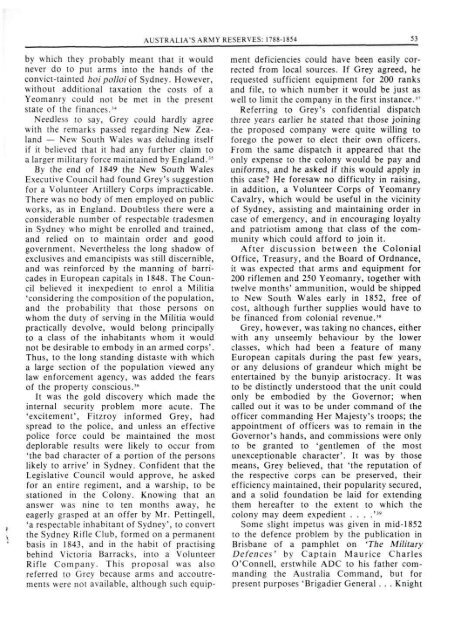ISSUE 34 : May/Jun - 1982 - Australian Defence Force Journal
ISSUE 34 : May/Jun - 1982 - Australian Defence Force Journal
ISSUE 34 : May/Jun - 1982 - Australian Defence Force Journal
Create successful ePaper yourself
Turn your PDF publications into a flip-book with our unique Google optimized e-Paper software.
AUSTRALIA'S ARMY RESERVES: 1788-1854 53<br />
by which they probably meant that it would<br />
never do to put arms into the hands of the<br />
convict-tainted hoi polloi of Sydney. However,<br />
without additional taxation the costs of a<br />
Yeomanry could not be met in the present<br />
state of the finances.' 4<br />
Needless to say, Grey could hardly agree<br />
with the remarks passed regarding New Zealand<br />
— New South Wales was deluding itself<br />
if it believed that it had any further claim to<br />
a larger military force maintained by England."<br />
By the end of 1849 the New South Wales<br />
Executive Council had found Grey's suggestion<br />
for a Volunteer Artillery Corps impracticable.<br />
There was no body of men employed on public<br />
works, as in England. Doubtless there were a<br />
considerable number of respectable tradesmen<br />
in Sydney who might be enrolled and trained,<br />
and relied on to maintain order and good<br />
government. Nevertheless the long shadow of<br />
exclusives and emancipists was still discernible,<br />
and was reinforced by the manning of barricades<br />
in European capitals in 1848. The Council<br />
believed it inexpedient to enrol a Militia<br />
'considering the composition of the population,<br />
and the probability that those persons on<br />
whom the duty of serving in the Militia would<br />
practically devolve, would belong principally<br />
to a class of the inhabitants whom it would<br />
not be desirable to embody in an armed corps'.<br />
Thus, to the long standing distaste with which<br />
a large section of the population viewed any<br />
law enforcement agency, was added the fears<br />
of the property conscious. 16<br />
It was the gold discovery which made the<br />
internal security problem more acute. The<br />
'excitement', Fitzroy informed Grey, had<br />
spread to the police, and unless an effective<br />
police force could be maintained the most<br />
deplorable results were likely to occur from<br />
'the bad character of a portion of the persons<br />
likely to arrive' in Sydney. Confident that the<br />
Legislative Council would approve, he asked<br />
for an entire regiment, and a warship, to be<br />
stationed in the Colony. Knowing that an<br />
answer was nine to ten months away, he<br />
eagerly grasped at an offer by Mr. Pettingell,<br />
'a respectable inhabitant of Sydney', to convert<br />
the Sydney Rifle Club, formed on a permanent<br />
basis in 1843, and in the habit of practising<br />
behind Victoria Barracks, into a Volunteer<br />
Rifle Company. This proposal was also<br />
referred to Grey because arms and accoutrements<br />
were not available, although such equipment<br />
deficiencies could have been easily corrected<br />
from local sources. If Grey agreed, he<br />
requested sufficient equipment for 200 ranks<br />
and file, to which number it would be just as<br />
well to limit the company in the first instance."<br />
Referring to Grey's confidential dispatch<br />
three years earlier he stated that those joining<br />
the proposed company were quite willing to<br />
forego the power to elect their own officers.<br />
From the same dispatch it appeared that the<br />
only expense to the colony would be pay and<br />
uniforms, and he asked if this would apply in<br />
this case He foresaw no difficulty in raising,<br />
in addition, a Volunteer Corps of Yeomanry<br />
Cavalry, which would be useful in the vicinity<br />
of Sydney, assisting and maintaining order in<br />
case of emergency, and in encouraging loyalty<br />
and patriotism among that class of the community<br />
which could afford to join it.<br />
After discussion between the Colonial<br />
Office, Treasury, and the Board of Ordnance,<br />
it was expected that arms and equipment for<br />
200 riflemen and 250 Yeomanry, together with<br />
twelve months' ammunition, would be shipped<br />
to New South Wales early in 1852, free of<br />
cost, although further supplies would have to<br />
be financed from colonial revenue. 38<br />
Grey, however, was taking no chances, either<br />
with any unseemly behaviour by the lower<br />
classes, which had been a feature of many<br />
European capitals during the past few years,<br />
or any delusions of grandeur which might be<br />
entertained by the bunyip aristocracy. It was<br />
to be distinctly understood that the unit could<br />
only be embodied by the Governor; when<br />
called out it was to be under command of the<br />
officer commanding Her Majesty's troops; the<br />
appointment of officers was to remain in the<br />
Governor's hands, and commissions were only<br />
to be granted to 'gentlemen of the most<br />
unexceptionable character'. It was by those<br />
means, Grey believed, that 'the reputation of<br />
the respective corps can be preserved, their<br />
efficiency maintained, their popularity secured,<br />
and a solid foundation be laid for extending<br />
them hereafter to the extent to which the<br />
colony may deem expedient . . . .'"<br />
Some slight impetus was given in mid-1852<br />
to the defence problem by the publication in<br />
Brisbane of a pamphlet on 'The Military<br />
<strong>Defence</strong>s' by Captain Maurice Charles<br />
O'Connell, erstwhile ADC to his father commanding<br />
the Australia Command, but for<br />
present purposes 'Brigadier General . . . Knight

















